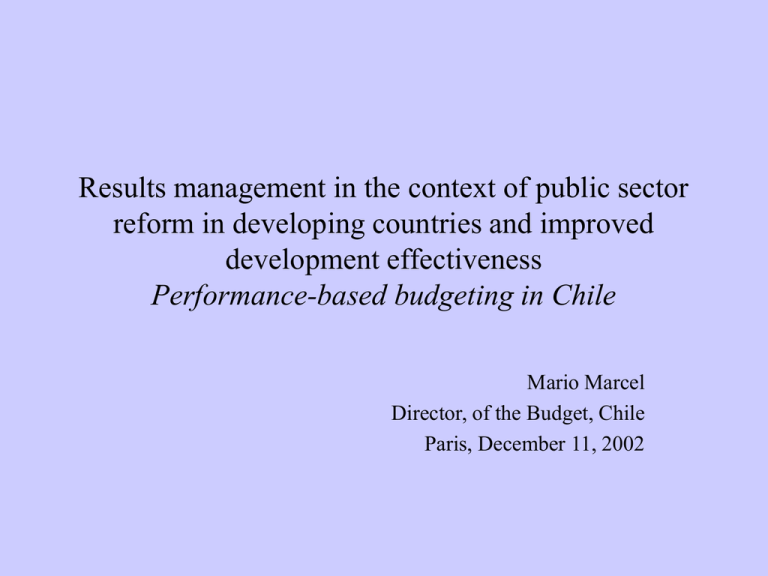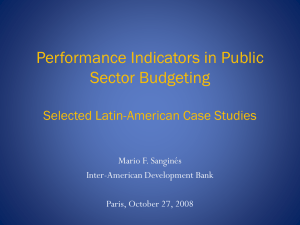Results management in the context of public sector reform
advertisement

Results management in the context of public sector reform in developing countries and improved development effectiveness Performance-based budgeting in Chile Mario Marcel Director, of the Budget, Chile Paris, December 11, 2002 PERFORMANCE BUDGETING APPROVAL PREPARATION EXECUTION EVALUATION PERFORMANCE BUDGETING TOOLBOX IN CHILE • • • • • Performance indicators Program evaluation Bidding fund Comprehensive management reports Management improvement programs PERFORMANCE INDICATORS • • • • Tells how a government organization is performing over time Agencies compete with their past record Ongoing, periodical information Measure performance in different: – Dimensions (effectiveness, efficiency, economy, service quality) – Delivery levels (process, output, outcome) • Chilean experience: – Started 1994 – Incrementalist approach, starting on voluntary basis – Subject to growing quality standards – Budget-related – Disclosure policy: Congress and general public PERFORMANCE INDICATORS PERFORMANCE INDICATORS 2003 BUDGET Areas of government Process Output Interm Outcome Final Total Total General administration 79 83 37 16 53 215 Social 90 268 84 58 142 500 70 239 176 527 65 186 13 87 78 273 324 1039 Economic Total PROGRAM EVALUATION • Aimed at telling whether government is doing the right things • Assess programs against their stated aims and expected results • Chilean experience: – Started 1997 – Budget-related – Programs selected with Congress – Performed by independent evaluators through panels of experts – Panels with authority to request information, commission studies – Counterpart in ministries/agencies in charge of programs – Based on logical framework methodology – Desk, in-depth, or comprehensive evaluations – Delivered in 4 to 9 months – Reported to Budget, Congress and the public PROGRAM EVALUATION PROGRAM EVALUATIONS 1997-2002 Desk evaluations Impact evaluations Comprehensive expenditure reviews Total 1997 2000 2001 2002 Total 1999 80 20 18 14 132 2 4 6 1 80 20 20 1 BIDDING FUND •Started 2000 with preparation of 2001 Budget •Competitive bidding mechanism to improve rationale of budget allocations •Aimed at moving away from incrementalist practices •Inertial spending strictly constrained •From comparison with spending ceilings, unallocated pool of resources Unallocated pool Current Budget Inertial spending BIDDING FUND • Ministries submit bids for resources from pool • Bids based on logical framework matrix (aims, goals, expected results, components, indicators, target population) • Many programs with sunset clauses • Finance makes proposal on basis of quality, consistency with government priorities and strategies, President makes final decision COMPREHENSIVE MANAGEMENT REPORTS • Started 1997, from Executive-Congress agreement • Conceived as accountability mechanism • Report performance against stated mandates, goals, commitments, resources • Supports compliance with other management control mechanisms (performance indicators, program evaluation, management improvement programs) and financial management regulations • Standard report format defined by Finance • Distributed to Congress, publicly available • Basis for institutional report in next budget submission MANAGEMENT IMPROVEMENT PROGRAMS • • • • • • • • Started 1998, from agreement with public sector unions Reward mechanism for central government employees Bonus determined by organizational performance Aimed at assessing progress in managerial systems development Managerial systems in 7 areas: – Human resources – Customer service – Strategic planning and management control – Internal auditing – Decentralization – Financial management – Gender focus Every area divided into systems Progress in every system coded through descriptors Government agencies assess their current situation and propose next stage to attain MANAGEMENT IMPROVEMENT PROGRAM 2002 Areas Stage Systems Staff training HUMAN RESOURCES X Workplace safety X Staff performance assesment CUSTOMER SERVICE X Complaints management X Red tape X STRATEGIC PLANNING/ MANAGEMENT CONTROL INTERNAL AUDITING Strategic planning/management control DECENTRALIZATION Decentralization programs FINANCIAL MANAGEMENT Procurement and hiring X Accounting X GENDER FOCUS X Internal auditing X Gender focus X X CHARACTERISING THE REFORMS • • • • • Strongly related to budget process Use of a toolbox of instruments Consistent implementation over 8 years “User friendly”, more emphasis on experience than on legislation Not just transfer from advanced countries, some innovations of our own SOME “PERFORMANCE INDICATORS” •System operational, not just blueprint •Change in officials’ mindset •Growing capacity to mobilize resources •Change in composition of spending KEYS TO “SUCCESS” • Chile’s experience proves that it is possible to build and operate a performance monitoring system in a developing country • The Chilean reform process was motivated not by crisis, but by frustration • But, be aware of enabling factors: – – – – – – – – Strong public institutions Honest civil servants Statistics Executive agencies Streamlined public sector: privatization, decentralization, contracting out Healthy public finances, growth environment Hierarchical budget institutions Budget process, procedures and tight schedules link with public sector culture CHALLENGES • • • • • • Consolidation of reforms and political support Different views of PS modernisation in people´s minds Strengthen link with development goals Balance between effectiveness and transparency Performance, trust and devolution Human resources development, pay systems KEY QUESTIONS • To what extent are improvements in the public sector in a country, especially a strengthened results focus, necessary for enhancing partnerships and achieving better development outcomes? – Results-orientation changes the public sector culture, otherwise, focus on development outcomes nearly impossible – Developing a full-blown performance management system not necessary – Pilots: organizations or management areas? • How can reformers encourage political authorities to emphasize a results focus in the public sector reform process? – – – – Find a powerful pre-existing structuring process (Ex.: Budget) Involve legislatures Open to the public Sensible formulation of goals and measures to avoid frustration (Ex.: Poverty reduction) KEY QUESTIONS • How do partners go beyond measurement to use the results framework to strengthen their capacity for policy analysis, policy formulation, monitoring and evaluation and to inform the development of new/successor strategies? – Measurement as a learning process – Necessary based on toolbox; no single measure can answer all questions – Key requisite: link with decisionmaking on public policies – CONTINUITY









